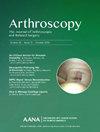Editorial Commentary: Anatomic Tibiofibular and Partially Anatomic-Based Fibular Posterolateral Corner Reconstruction Techniques Are Biomechanically Superior to Nonanatomic Reconstruction Techniques: A Tibial Tunnel Is the Gold Standard for an Anatomic Reconstruction
IF 4.4
1区 医学
Q1 ORTHOPEDICS
Arthroscopy-The Journal of Arthroscopic and Related Surgery
Pub Date : 2025-05-01
DOI:10.1016/j.arthro.2024.11.053
引用次数: 0
Abstract
Nearly 2 decades ago, the posterolateral corner (PLC) was commonly referred to as the “dark side” of the knee because of our limited anatomical understanding, no anatomic-based reconstruction techniques, and high rates of clinical failures. During this time, nonanatomic PLC-reconstruction techniques, or “fibular slings,” gained popularity early on as a result of the ease of the procedure; however, clinical studies demonstrated residual varus gapping and external rotation laxity associated with these nonanatomic techniques that only reconstructed the fibular (lateral) collateral ligament. The term “anatomic” PLC reconstruction generally refers to a procedure that aims to restore the entirety of the 3 main PLC static stabilizers. Currently, the most commonly used PLC-reconstruction techniques have evolved to be either a complete anatomic reconstruction with a tibiofibular-based (LaPrade and Engebretsen) approach or a partial anatomic reconstruction through a fibular-based (Levy/Marx, Arciero) technique. Both reconstruction approaches incorporate the use of a second femoral tunnel for improved restoration of the femoral attachments of the fibular (lateral) collateral ligament and popliteus tendon and are biomechanically superior compared with the historic nonanatomic techniques. As such, these improved PLC-reconstruction techniques, whether tibiofibular-based or fibular-based, are strongly recommended over nonanatomic reconstruction techniques. Compared with the fibular-based approach, an anatomic tibiofibular-based PLC reconstruction more closely recreates the native architecture of the PLC with recreation of the popliteofibular ligament and use of a tibial tunnel to restore the static function of the popliteus tendon. In addition, certain conditions, such as concurrent proximal tibiofibular joint instability and asymmetric knee hyperextension, are contraindications to using fibular-based reconstructions and should always use a tibial tunnel.
编辑评论:解剖胫腓骨和部分解剖腓骨后外侧角重建技术在生物力学上优于非解剖重建技术:胫骨隧道是解剖重建的黄金标准。
近二十年前,后外侧角(PLC)通常被称为膝关节的 "阴暗面",因为我们对解剖学的理解有限,没有基于解剖学的重建技术,而且临床失败率很高。在此期间,非解剖型 PLC 重建技术或 "腓骨吊带 "因其手术简便而在早期大受欢迎;然而,临床研究表明,这些仅重建腓骨(外侧)副韧带(FCL)的非解剖型技术会产生残余的屈曲间隙和外旋松弛。解剖性 "PLC 重建术一般是指旨在恢复整个 3 条主要 PLC 静态稳定韧带的手术。目前,最常用的 PLC 重建技术已经发展为基于胫腓骨的完全解剖重建(LaPrade 和 Engebretsen)方法或基于腓骨的部分解剖重建(Levy/Marx 和 Arciero)技术。这两种重建方法都使用了第二个股骨隧道,以更好地恢复 FCL 和腘绳肌腱 (PLT) 的股骨附着处,在生物力学上优于以往的非解剖技术。因此,无论是基于胫腓骨还是基于腓骨的 PLC 重建技术,都比非解剖重建技术更值得推荐。与基于腓骨的方法相比,基于胫腓骨的解剖型 PLC 重建通过重建 PFL 和使用胫骨隧道恢复 PLT 的静态功能,更接近 PLC 的原生结构。此外,某些情况下,如并发近端胫腓关节不稳定和不对称膝关节过伸,是使用腓骨重建的禁忌症,应始终使用胫骨隧道。
本文章由计算机程序翻译,如有差异,请以英文原文为准。
求助全文
约1分钟内获得全文
求助全文
来源期刊
CiteScore
9.30
自引率
17.00%
发文量
555
审稿时长
58 days
期刊介绍:
Nowhere is minimally invasive surgery explained better than in Arthroscopy, the leading peer-reviewed journal in the field. Every issue enables you to put into perspective the usefulness of the various emerging arthroscopic techniques. The advantages and disadvantages of these methods -- along with their applications in various situations -- are discussed in relation to their efficiency, efficacy and cost benefit. As a special incentive, paid subscribers also receive access to the journal expanded website.

 求助内容:
求助内容: 应助结果提醒方式:
应助结果提醒方式:


